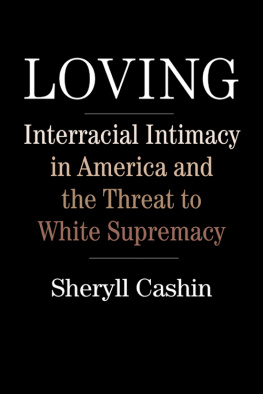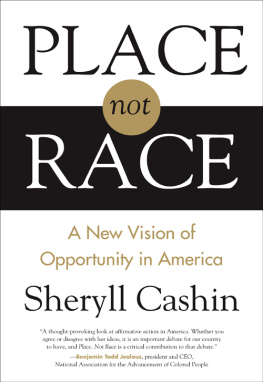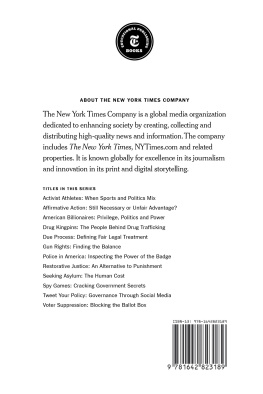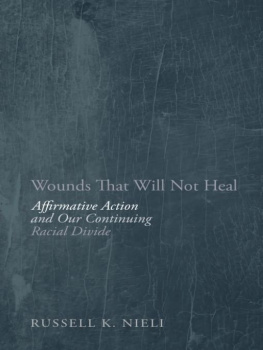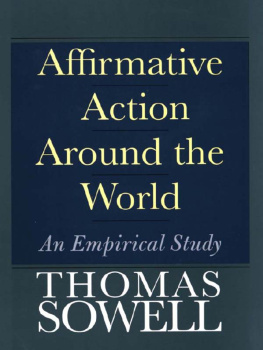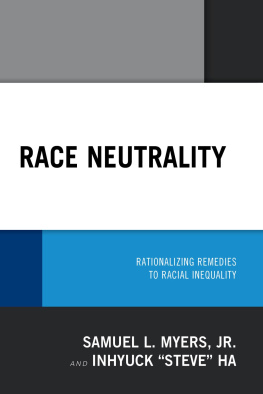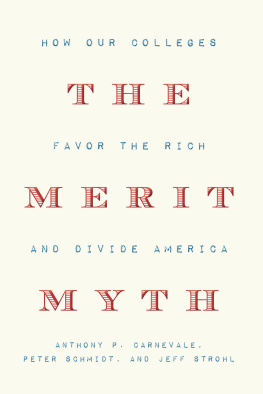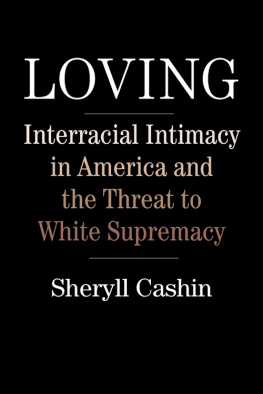OTHER BOOKS BY SHERYLL CASHIN
Place, Not Race: A New Vision of Opportunity in America
The Agitators Daughter: A Memoir of Four Generations
of One Extraordinary African-American Family
The Failures of Integration: How Race and Class
Are Undermining the American Dream

For Dorothy Reed,
my cousin-angel
AUTHORS NOTE
A s a daughter of civil rights activists and a descendant of slaves and slaveholders, I wrote this book from a personal perspective. Because my life experience and voice shape this and all my work, I feel obligated to disclose the source of my admiration for agitators who cross lines. It begins with amazing parents who lived their personal creeds, sometimes at great cost.
Joan and John Cashin were among the happy warriors who planned and participated in the sit-in movement in Huntsville, Alabama, in 1962. Tired of waiting for equality, they and other Huntsvillians organized, marched, and demanded to be served. One element of their strategy was to recruit white allies from the local Unitarian church. The Unitarians, too, would march for black freedom. My parents and some of these long-haired people became dear friends. This biracial group of activists laughed a lot and called themselves the Drek Set. They were irreverent and playful in undermining white supremacy.
They infiltrated white citizens council meetings. They desegregated the Grand Ole Opry in Nashville through a ruse in which a white couple played maid and chauffer to my resplendent parents as they stepped out of an antique Rolls Royce. Another white couple purchased a house with my parents money and deeded it to them, enabling Cashins to integrate a neighborhood and a public school with a program for hearing-impaired childrena program that my brother needed. My parents were proud graduates of Fisk, a venerable, historically black university. They celebrated the genius of black folk and devoted their lives to helping those who had less than they did. They also opened their home to a steady stream of people of all races and ethnicities. The common thread among our guests was that they had stimulating things to say and were passionate about social justice.
In 1962, as part of their strategy for bringing national attention and allies to Huntsvilles sit-in movement, my mother sat down at a lunch counter, with mea four-month-old infantin her arms. She was arrested and taken to jail, along with another black doctors wife, who was eight months pregnant. This was the turning point in their movement. A city concerned with its image and future in the space industry soon relented and desegregated its public accommodations a year before the children of Birmingham ignited the conscience of the nation.
Then my parents turned to politics. My father grew up hearing about his grandfathers exploits as a member of the Alabama legislature during Reconstruction. Herschel V. Cashin, the son of a white slave owner and a mixed-race woman of African descent, was a Radical Republican and my fathers hero. Dad had a lifelong dream of reigniting the spirit of Reconstruction in Alabama, of finishing Grandpa Herschels work. Dad was a dentist by profession but an agitator by disposition. He founded a political party, the National Democratic Party of Alabama (NDPA), to give poor black sharecroppers newly enfranchised by the Voting Rights Act an alternative to the party of George Wallace.
NDPA was born in 1967, the same year that Loving v. Virginia was decided. Both were assaults on white supremacy. The traditional Alabama Democratic Party reluctantly had given up its official slogan, White Supremacy for the Right, the year before. Through NDPA, blacks elected themselves to local office throughout the Black Belt, where the plantation economy had once reigned. And they returned a black man to the Alabama legislature for the first time since Reconstruction. NDPA was also backed by a biracial group of riotously humorous change agents. I inherited their sense of humor, irreverence, and impatience with supremacy. I also learned from my parents that good people come in all colors and that with allies and activism, any situation can be made better.
INTRODUCTION
T o love beyond boundaries is the most radical of acts. It also requires optimism. Richard Loving must have followed the light of his surname. In news clips he didnt smile much, perhaps because his teeth were irregular. He didnt look the part of an ardent integrator. His buzz cut, rugged face, and tobacco-scarred Southern accent marked him as a white, working rural man of simple means and tastes.
Like many Southerners, Loving knew people of color. But his relations with them were more intimate than most whites were willing to countenance. His father worked on a farm for a prosperous man of color, and his parents home was down in the community where all the Indians lived, according to a resident. Loving and friends would gather at a favorite bend in the road or at the back of a general store they had turned into a juke joint. Someone would bring a guitar or a fiddle, and this motley crew would play music and hang out together. They were black, white, racially ambiguous high yellow, or Indian, depending on the perspective of who was observing and who was claiming labels. Their crossing of color lines irritated the county sheriff, who literally was the race police and tried to break up their fun. Loving was perhaps the most culturally dexterous among this group. He could blend in with anybody, people said. He was playful and lived the life he wanted, loved the red-brown girl he wanted, drag-raced cars with his high-yellow friends. In the 1950s, in Central Point, Virginiaa hamlet with a penchant for race mixinghe and others willfully defied the old Jim Crow.
Mildred Jeter Loving accorded with central casting. In a documentary about the couple and the Supreme Court case that she and her husband brought fifty years ago, she played herself better than any actress could. She was dignified, slender, and pretty, with a quiet voice that made people lean in to hear her. Richard called her Bean, short for String Bean. She dressed like the housewife that she was; her short, bobbed hair was fuzzy at the roots but ended in shiny curls that betrayed either her complicated lineage or the pressing comb. She appeared to be a Negro or colored, words then used to describe African Americans, although as this book later describes, she identified herself as a descendant of an indigenous nation rather than slaves.
In 1958, Mildred and Richard were arrested and jailed for the felony crime of marrying. Virginia was among sixteen states in that era still sufficiently obsessed with the purity of its white citizens bloodlines to ban whites from marrying nonwhites, with varying definitions for who could claim whiteness. From 1661 until the Supreme Court ruled against such measures in the Loving case, forty-one states had enacted statutes that penalized interracial marriages.
There were legal bans, and there were social ones. Marrying, loving, and having sex across lines of phenotype were not considered normal or acceptable among most people in pre-civil-rights America. In 1958, only 4 percent of Americans approved of marriages between blacks and whites.
On June 12, 1967, the Supreme Court sided with the Lovings. The civil rights revolution had roiled from a Woolworths lunch counter in Greensboro, North Carolina, to a thousand similar nonviolent protests in over one hundred Southern cities, resulting in over twenty thousand arrests. When Police Commissioner Bull Connor turned water hoses and attack dogs on child protesters in Birmingham, Alabama, people of goodwill supported the protesters, as did moderate Republicans in Congress, who added their votes to overcome the staunch opposition of segregation-forever Southern Democrats. The Civil Rights Act of 1964 barred discrimination in education and employment and allowed people of color to dine, shop, and travel where they wanted. The Voting Rights Act of 1965 began to desegregate politics. In

